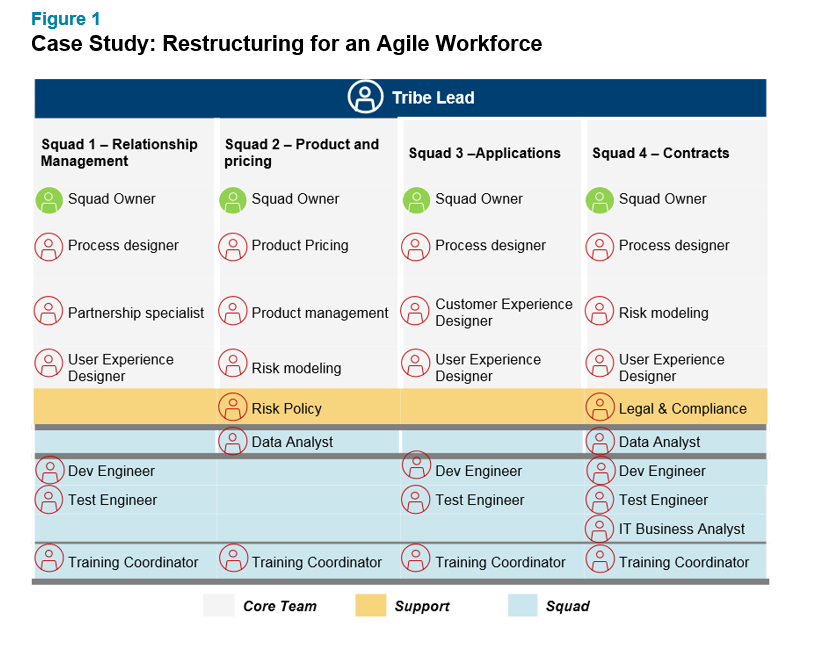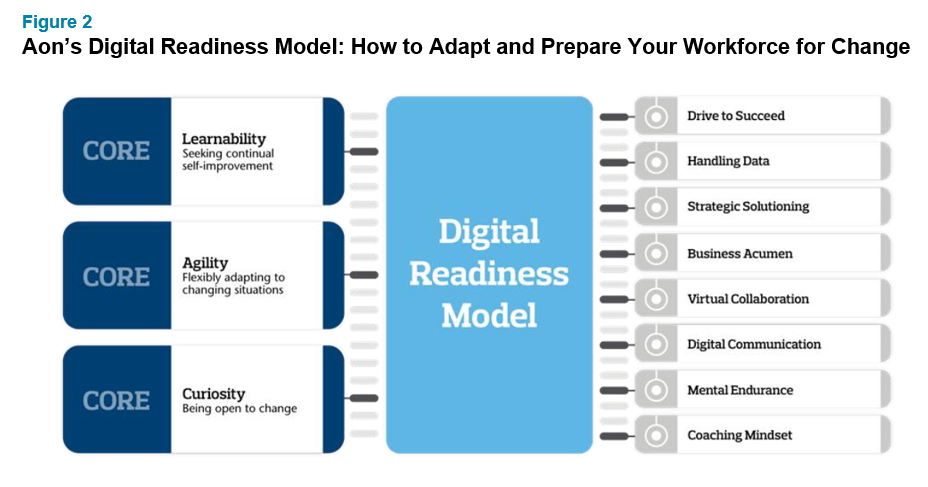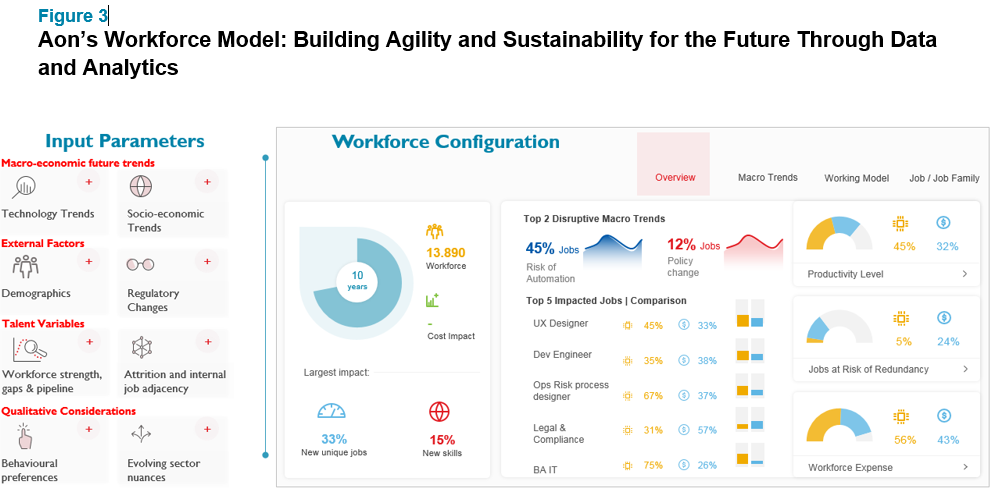Even before the COVID-19 pandemic, firms in Asia were adapting their workforce strategies to ensure a better position for the future of work. However, disruption from the crisis has caused many organizations to go back to the drawing board and reset their strategies.
 For many firms, preparing for the future of work has been in progress for most of the last decade. In recent years, 30% to 70% of businesses across industries have reduced their workforce due to automation and 20% to 70% have expanded their workforces by creating new jobs.[1] While this range varies by sector, we see these trends to some degree among nearly every business in today’s evolving world. Within Asia, organizations have also embarked on mid- to long-term transformation journeys, backed by high growth in emerging markets, as businesses continue to find ways to engage an untapped customer base with the help of technology and innovation.
For many firms, preparing for the future of work has been in progress for most of the last decade. In recent years, 30% to 70% of businesses across industries have reduced their workforce due to automation and 20% to 70% have expanded their workforces by creating new jobs.[1] While this range varies by sector, we see these trends to some degree among nearly every business in today’s evolving world. Within Asia, organizations have also embarked on mid- to long-term transformation journeys, backed by high growth in emerging markets, as businesses continue to find ways to engage an untapped customer base with the help of technology and innovation.
The process has been slow but steady. Firms have been charting their journeys over the course of three to five years, or longer in some cases, making sure to maintain financial stability while focusing on the future. Yet, the unprecedented circumstances presented by the COVID-19 pandemic have disrupted transformation journeys. Many changes were accelerated, such as remote working, and others were sidelined, including firms’ focus on immediate shareholder returns and top-line growth in favor of long-term value generation and running a profitable business.
This pause is not necessarily bad. Times of change often bring businesses back to the drawing board, offering an opportunity to rethink and reset strategies for the future. According to our latest pulse survey results, which were published on June 17, 44% of companies in Asia are considering long-term restructuring of their operations and workforce.
As firms continue to move ahead with their plans, it’s important to ensure the right foundations are in place. Go back to the basics as you rethink the type of jobs, working models and talent preferences that are relevant. Every strong business plan with sustainable strategies starts with having knowledge of your firm’s core beliefs. This article takes a closer look at the three “Ds”— design, direction and demand — foundational elements to consider when preparing your organization for sustainable growth in the new normal.
Design: Adapting Business Models to Create Value
Workforce composition is changing across the board. Organizations are shifting from hierarchical structures to technology-enabled networks and teams, which work closely with customers and are empowered to make decisions. Traditional structures were designed for efficiency, supporting the previous goal to complete tasks at a faster pace. These structures ran like well-oiled machines and got the job done. But, were they enough? Demands are changing. We have gone from a model that organizes individuals based on functional capabilities to one that ensures individuals are aligned with activities that create value.
As a result, firms are focusing their efforts on developing cross-functional teams that can be redeployed in an agile manner to follow along with the speed of change — which is happening faster in response to the effects of the COVID-19 pandemic. Skills need to assemble quickly and structures need to be built around supporting continuous improvement and solving client problems to help navigate the client journey. Throughout the process, leadership plays the role of an enabler, assisting teams in achieving these goals for the future of work. Findings from our pulse study revealed that 78% of companies in Asia envision agile working as the ‘new normal.’
Our recent partnership with a bank in Southeast Asia that reimagined its entire banking process for its mortgage business (consumer lending) is a solid case in point. The bank created an agile structure to exploit its digital and online channels to provide client solutions. They are restructured as tribes or cross-functional teams that form and dissolve quickly and are geared towards solving a problem statement for the client with a quick turnaround.

Each tribe has squads and chapter members to address particular outcomes. For example, one squad could be focused primarily on relationship management, another on production, a third on pricing, and so on. Each squad is comprised of a leader and members, who are hired directly into the squad based on its specialization. The cross-functional expertise in the tribe comes from the chapter members, who provide the necessary inputs to ensure value is delivered to the client on time.
In order to successfully support future models like this, firms should have a process in place to understand how prepared their people are and ensure a smooth transition into new roles to meet new demands. A good place to start is by establishing agility. The underlying themes of an agile workforce include:
- Collaborative structures: It’s important to break down any silos. Functions and job families should permit overlaps and encourage collaboration.
- Centralized teams: Aim to centralize your specialist teams. This allows employees to work across various products and geographies depending on current business needs. This holistic view of skills is a quality firms should keep driving.
- Accountability: With this bigger picture mindset, employees now have additional responsibilities. They are no longer solely focused on the task at hand, and, in many cases, will be held accountable for high-authority decision making.
- Increased trust: With new perspectives now added to the mix, building trust by fostering effective manager relationships is essential. Everyone is in this together.
View our previously published infographic, “Develop an Agile Mindset in Your Workforce,” for additional steps and advice.
Direction: Engaging Employees in a Common Direction and Creating New Competencies
In our experience working with clients, most business leaders and CHROs agree that agility and collaboration are critical to their organization’s success. Roles are adapting and changing structures and competencies. Consequently, companies are left with challenges related to the acquisition and retention of skill-specific employees needed to address emerging areas of technology within their business. In fact, nearly a quarter of the organizations surveyed claimed that their firm was not digitally ready for the future of work. Figure 2 provides a view of Aon’s Digital Readiness Model, which focuses on the three core areas to instill in your workforce to positively position your business for the current and future technology-driven world.

Let’s revisit the bank case study mentioned earlier. The skills and competencies built across the chapters and squads for addressing client needs are diverse. While many of the underlying technical skills remain constant, their application needs to change. At its core, the digital mindset of learnability, agility and curiosity takes precedence over the technical skill set. For example, leaders can usually transition into different chapters easily since the competency required is mostly based on leadership and business acumen, translating into strategy rather than technicality.
In order to support this agile model, firms must provide career and learning opportunities to engage their employees. Career paths should now follow a climbing wall instead of a ladder, where employees can choose various lateral moves within their organization and take their own, holistic journey forward, while allowing the organization to build flexibility in its workforce deployment and planning. In fact, our survey found that 58% of companies in Asia felt that better leadership training in agility, managing virtual teams and crisis management would have helped align their workforce for success during the COVID-19 pandemic. This includes increased investment in developing agility to enable a seamless transition into different ways of working.
Below are key points to remember when establishing the infrastructure needed for identifying and grooming talent for the future:
- Job Architecture: Refine job architecture to promote internal mobility.
- Digital Readiness: Determine digital readiness through assessment of employees.
- Competency Identification: Build a repository of competencies critical to the business.
- Career Pathways: Provide a view of career pathways to employees to drive engagement.
Demand: Driving a Sustainable Business for the Future
Workforce productivity is quickly becoming key to driving a sustainable business. And the way to achieve greater productivity is through a capability-based workforce versus a role-based workforce. This shift is being driven by rapid technology changes, the evolution of skills, an increased need for global talent pools and cost pressures. Knowing when you’ve achieved greater productivity won’t be easy, as 38% of companies in Asia say they struggle to measure productivity of their employees today, according to our pulse survey.
When addressing these core themes, it’s essential to maintain a firm-wide perspective that is catered to current business needs and backed by market data. Results will be that much stronger.
When working with our banking client, it became clear that a robust workforce model reinforced by data and analytics allows firms to fast-track their transformation, equipping leaders with the ability to assess various options and risks as well as make informed decisions around talent, all while facilitating a streamlined employee and customer experience along the journey.

Next Steps
The humanitarian and economic toll of the COVID-19 pandemic has presented many challenges for firms in Southeast Asia and around the world. Many organizations have learned that they are, in fact, ready for a significant change to their operational and workforce structure. And, because of the emergent crisis, they are accelerating their plans to make necessary changes to position their firms for a stronger future. Apply the foundational elements of design, direction and demand to new strategic plans. Doing so will help you make informed decisions that can ultimately differentiate you from your competitors.
To read more articles on how rewards professionals can respond to the COVID-19 pandemic, please click here.
To learn more about participating in a survey or to speak with a member of our rewards consulting group, please write to rewards-solutions@aon.com.